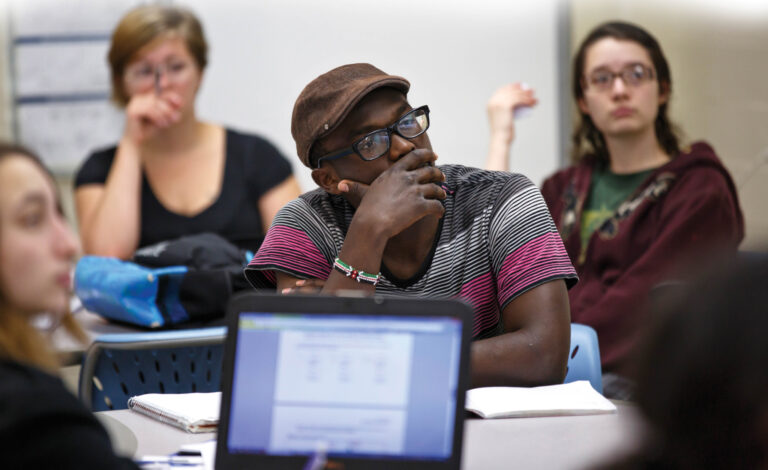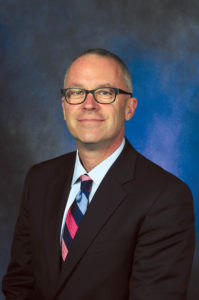 By Chad Berry, academic vice president and dean of the faculty
By Chad Berry, academic vice president and dean of the faculty
Higher education appears to be in the midst of great change. The last ten years have seen the decline of public support for public higher education through tax revenues, the rise (and fall) of MOOCS (Massive Online Open Courses) in particular, along with the proliferation of online programs in general, the criticism of for-profit higher education providers, and, even more recently, the questioning of whether the cost of higher education still provides value. Amid such change, though, there is still a great deal of continuity. Students continue to attend college, graduate students continue to choose a career in higher education through pursuit of a terminal degree, and private and public higher education continues to sustain itself despite all these challenges.
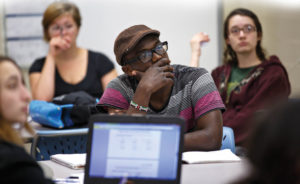
Berea College has largely been immune from many of the most vexing challenges; the College is blessed with an endowment that continues to provide a high-quality education. Students continue to seek out Berea for the promise it provides, typified by a residential educational experience with close faculty-student and staff-student face-to-face relationships with high expectations, even higher levels of support, and powerful mentoring. And the College has long integrated deep learning in the sciences and nursing in a predominantly liberal arts setting with very successful graduates in the sciences and nursing going on to do great things for society.
The planning work of faculty and staff in the natural sciences, mathematics, and nursing around the kind of learning spaces that will continue to inspire, challenge, and prepare the next generations of students in the natural sciences and health professions has taken place within this context of change and continuity. The new Margaret A. Cargill Natural Sciences and Health Building is the result of this deep thinking and careful planning.
Quite simply, Berea’s existing science building is well past its prime. Its shallow floor plan with a central hall make classrooms long and narrow, inhibiting flexibility. Its laboratories and the building piers in each room limit sight lines and interaction. It is a very old structure, and mechanical, engineering, and plumbing challenges make it expensive to operate and difficult to keep comfortably heated and cooled in a sustainable manner. The Hafer-Gibson Nursing Building is also outdated and rather inflexible given its peculiar shape and design. Berea faculty and students, in typical fashion, have made the best of outdated buildings, and students’ academic and professional success has been in spite of such buildings, not because of them.
In the last two decades, science and nursing education in particular have changed rather dramatically, especially focusing on seeking to educate more students in the STEM (science, technology, engineering, and mathematics) fields and in nursing. (At Berea, we sometimes inclusively call this STEM-N to include nursing.) Politicians, researchers, CEOs, healthcare leaders, and many others all agree the U.S. must continue to fix the “leakage” of students in the STEM-N pipeline, which describes the attrition that occurs as students who think they want to major in the sciences or nursing eventually become discouraged and move on to another major. Why do we need more STEM-N students? The answers run the gamut from national security concerns to healthcare crises as the population ages and as nursing shortages intensify.
Much of the attention on ensuring more students are attracted to STEM-N involves not just how students are taught, but where. Over a decade or more, natural sciences and nursing buildings have continued to evolve in alignment with latest pedagogical concerns, approaches, and developments. Berea College is the beneficiary of such building planning and design elsewhere, and the new Cargill building represents the collective learning of such work nationally. Several features of the Cargill building reflect the cumulative thinking of design approaches, as faculty and staff and administrators have visited at least a half dozen or more recent buildings across the country.
While the exterior of the building is designed to be iconic and to reflect the campus’s predominant architecture of the Georgian Revival—in keeping, for example, with Draper, Frost, and even the existing Hall Science Building—the inside of the building is very modern. For example, the interior of the building makes extensive use of transparent glass walls to appeal to students by letting in light and also inspiring and demystifying what occurs in classrooms and, particularly, labs. STEM-N buildings of yesterday, conversely, have solid interior walls and doors that blocked out any view into the room, making the act of “doing science” or “practicing nursing” quite stealthy and even befuddling to new students who might either be passing through a building or taking a general studies class in a building.
Such a transparent concept, often referred to as “science (and, in this case, nursing) on display,” is intentionally designed to inspire students who have not yet chosen a major; seeing students inside the building working with their peers on problem-based learning in classrooms, labs, or high-fidelity nursing simulation spaces seeks to transmit a “you-can-do-this-too” message. For this reason, most introductory courses and laboratories are intentionally placed in the central glass-walled stack that runs from the bottom floor up through the fourth. Even on he exterior, the building’s 17 group study spaces are visible day and night, conveying a rich academic learning culture to those walking near the building. All of these features are meant to inspire STEM-N students but also all students, who use the building. In this way, the new Cargill Building is meant to serve all of Berea’s students since all students have a general education requirement in science and in quantitative reasoning.
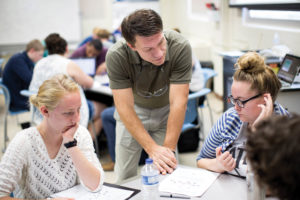
Second, classrooms overall are designed to be very flexible and effective as changes continue to occur in the pedagogy of learning spaces. Faculty and staff in the sciences, mathematics, and nursing programs were continually cognizant that they were designing a building for future students and colleagues rather than for themselves and for today’s students. So interior walls, lab spaces, and classrooms can rather easily be refined two decades from now as the need may arise. And while you may have taken introductory science and nursing courses in large, tiered classrooms, today’s classrooms, we know from published research, are more effective in smaller and more personable—and hence, more supportive—learning environments. So classroom sizes vary from 16 to 30 seats for the most part, and even the furnishings are intentionally designed to be flexible, easily transformed from a row format of students to groups of four students engaged in a learning activity and working together for its resolution. There continues to be a large tiered space that will seat approximately 100, but even this space is designed with flexibility in mind—seamlessly moving from a guest lecture to a planetarium show to an evening movie screening available to the entire campus. Research done both at Berea and elsewhere prove that spaces that accommodate active—rather than passive—learning, and learning that is student—rather than teacher—centered are more efficacious in fostering deep learning.
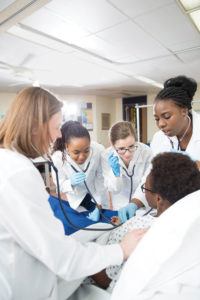
Third, the building has intentionally considered the growth in the number of students attracted to STEM-N as a result of the new learning environment. On average, new buildings promote an increase of 25 percent in students majoring in STEM-N, so the building design committee had to keep this in mind. Noteworthy here are the student project spaces for biology that will allow students to mount and conduct an experiment throughout a semester rather than having to take it down and set it up again, as is currently the case, because of a lack of space. And the building deliberately incorporates classroom and lab spaces for geology to return to the building, along with courses in archaeology. Finally, the building seeks to inspire not just current Berea students but also local students in K-12 schools through its Discovery Center, which can flexibly host and educate students on field trips to the new Cargill building.
Finally, the building is designed to be the home of all academic programs in Division I at the College: biology, chemistry, mathematics, nursing, and physics. There are great interdisciplinary and inter-professional opportunities for integrating programs and faculty together. Nursing students, especially, stand to gain a great deal from being near math faculty, for example, or just down the hall from the anatomy and physiology lab. Current nursing students have noted their excitement at being integrated in a building that includes relevant disciplines to nursing.
So in this new learning space, there is a great deal of change incorporated in how Berea will prepare its next generations of students in STEM-N. There will be new scientific equipment, new laboratory technology, new digital learning opportunities, and state-of-the-art high-fidelity mannequins onto which nursing faculty can simulate health situations and emergencies for nursing clinical teaching. And for many years to come, it will strengthen the place of science and nursing in Berea’s predominant liberal arts context, helping to challenge and inspire students to respond to the challenges of our century.


